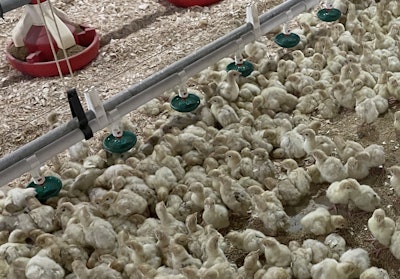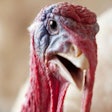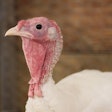
The moment poults are placed on the farm, their behaviors should be monitored and evaluated to ensure that they can grow to be healthy adult turkeys.
While speaking at the 2024 PEAK convention, Michele Behl, director of poult quality for Select Genetics, gave an overview of behaviors for turkey producers to assess within the first 12 hours of placement as the poults go through their “settling in” process.
How much are poults moving?
“Shortly after you start placing them on the ground, they should get up and start moving around,” Behl said. “They shouldn’t sit there and be lethargic.”
If the birds are comfortable and healthy, they should start to become evenly distributing through the barn. They should not be staying in the same spot where they were placed. Likewise, they should not be “clumping up or piling together.”
If lethargy is observed, it could be a result of the poultry being hatched to late, or placed too soon after the hatch.
But Behl said time is one of the best interventions for this kind of behavior. Too many times, producers have thought they were lethargic because they were cold. However, Behl said in doing so, you could overheat the birds, which can cause dehydration, starving or flipping over.
While minimal movement is concerning, Behl said it is important to observe the poults to make sure they aren’t moving too much. If they are running, that means they got hot and cold while being transported to the farm, and they are running because they are seeking a comfortable temperature.
She advises if the poults are running, you should temporarily raise the temperature in the barn and turn off the lights for a brief period of about 15-20 minutes.
Drinking and feeding
If poults immediately run to the feeders and drinkers, that could be a sign that they were either hatched too early or got too warm somewhere during transport.
If that happens, it is especially important to make sure both the feed lines and the drinkers are fully operational and accessible. It is also a good idea to add additional feeders and drinkers.
“The worst thing that you can do is have a bunch of birds that are thirst and hungry and they go to the feeders to where they can actually find them, and they’re dry,” she said.
If they don’t find feed or water, they will be inclined to “give up,” and will not have a future, she said.
Flipovers
If you notice that poults are flipping over within the first 30-60 minutes of placement, that is most likely a sign that the bird was taken in and out of its thermoneutral zone, or temperature range in which they feel the most comfortable, on multiple occasions.
If the poults get warm one time and come back to where they feel comfortable, usually flipovers don’t occur, she said. The situation should be the same if they get cold and then return to a comfort level.
But if they go in and out of their comfort multiple times, that’s when they are more prone to flipping.
She said if this happens, the majority of the poults can recover.
“A lot of times, they just need to be removed from the heat sources. You need to take them out, remove them from underneath the heaters and move them to a cooler area,” she said.
She also recommended placing them on a non-slippery surface, and making sure that when they are moved, that they still have access to feed and water.


















